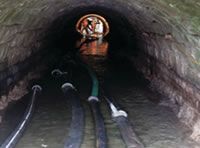Lanes Group team shows safety standards during culvert clean

Lanes Group has cleared 90 tonnes of silt and rubble from a large culvert to allow civil engineers to carry out a structural survey.
A team of drainage engineers from the company’s depot in Eccles, Greater Manchester, worked on the seven-week project in Etruria, Stoke on Trent, Staffordshire.
Lanes Group, the national drainage and maintenance solution specialist, was commissioned to carry out the work by Galliford Try, on behalf of Stoke on Trent City Council. Galliford Try Works Manager Jez Hurst said:
The Lanes team did a thorough job. They worked well within our safe systems of work for the project, and showed good health and safety standards throughout. It was a tough task, digging out a lot of rubble and mud, but they stuck to it, and completed the task within the timeframe we asked of them.
The culvert, which was two metres in diameter and 35 metres long, was over 90 per cent full of silt and debris.
Up to seven Lanes engineers worked on the project, observing strict confined space entry procedures, which included setting up a davit arm rescue winch above the culvert entrance.
Lanes Group’s health, safety, environmental and quality manager Paul McParland attended the site to advise on safe systems of work.
Simon Roberts, Area Development Manager for the Lanes Eccles depot, said:
Overpumping was put in place, and safety steps installed to gain access down the curved sides of the culvert. The culvert was filled with debris to within a couple of feet of its roof. We were able to vacuum out the silt using a jet vac tanker, but towards the bottom we found a thick layer of bricks and rocks which had to dug out by hand.
Half way through the project, the Lanes team discovered broken pieces of asbestos sheeting, which had to be removed by a specialist asbestos waste company before culvert cleaning work could start again.
Towards the end of the project, a civil engineer from Stoke on Trent City Council advised on how far down the Lanes engineers should dig to ensure the clay base of the brick-walled culvert remained intact.
Simon Roberts said:
The project combined strict attention to detail with regards health and safety and confined space working, with a determination to get a messy and tough job done in a timely fashion for the client.







